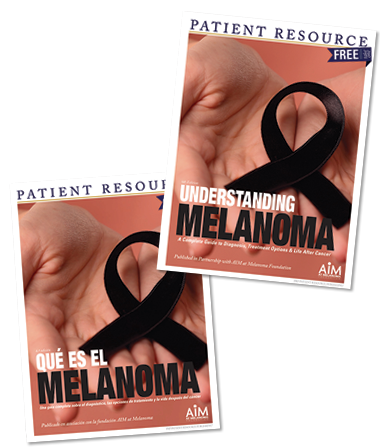
Melanoma
Follow-up care
Completing treatment for your primary melanoma is a triumph. You have partnered with your health care team and made it through treatment to reach this milestone. Although it is a reason to celebrate, it is important to realize that your journey isn’t over. You are at risk for a recurrence or a new melanoma, which makes follow-up care a necessary and critical part of your life.
Recurrence is when melanoma cells go undetected and survive treatment, then multiply enough to form a tumor. Your original diagnosis may offer some insight into your overall risk for recurrence. For example, early-stage (thin) melanomas generally tend to recur less often but over a longer period of time. Later-stage melanomas recur more often and over a shorter time period. For all stages, the risk of recurrence generally decreases over time, though it is never gone completely.
A new melanoma is different from a recurrence. Referred to as a new primary melanoma, this is one that appears somewhere on your body that is not related to the original melanoma. It is not uncommon to have a second melanoma of the skin due to the same risk factors that caused the first melanoma.
You can be proactive about your skin health in the following ways. Share this information with your friends and family also as everyone needs to monitor their skin.
ABCDE RULE: HOW TO DETECT A MELANOMA
Self-Exams
Performing self-exams involves checking yourself on a regular basis for any moles or spots that change shape, size or color. To confidently notice things that look or feel out of the ordinary, you have to know your body. Some places are impossible to see on your own. Ask a loved one or your doctor to check out those hard-to-see areas.
Keep in mind that although you will be familiar with what the melanoma from your original diagnosis looked like, a recurrence or new melanoma may not look the same. The images on the “ABCDE” rule will help you identify the common differences between a melanoma and a mole that is harmless (benign).
Melanoma can spread to lymph nodes, so a self-exam also includes feeling around for any abnormal lumps.
If you are unsure of anything or something concerns you, contact your doctor right away. Don’t wait until your next regularly scheduled doctor’s appointment.
Preventive Medical Appointments
Your doctor should provide you with a schedule to help you stay on track with follow-up appointments. The frequency of visits will be customized for you, based on the following:
- Your previous diagnosis and stage
- Type of treatment you received
- National recommended guidelines
- Your risk factors, such as a fair complexion, light-colored eyes, blonde or red hair, a history of blistering sunburns, a tendency to burn or freckle, large moles or many small moles and a family history of melanoma
During these check-ups, your doctor will conduct a thorough physical examination, paying special attention to your skin, watching for long-term side effects (called late effects) and any areas of concern that you mention. Because melanoma can spread to lymph nodes, your doctor will check those closely, too.
Blood tests, regular X-rays and other imaging studies are not usually done for earlier-stage melanoma follow-up, but they may help if you have signs or symptoms of a possible recurrence. If you are at a higher risk of having your melanoma return, your doctor may order one or more of these imaging studies:
- Chest X-ray
- Computed tomography (CT)
- Positron emission tomography (PET)
- Combined PET/CT
- Magnetic resonance imaging (MRI)
Healthy Habits
Making skin cancer prevention a lifelong habit is a smart idea. As your scheduled follow-up visits get further apart in the future, you can continue to be mindful of your risks and ways you can help prevent a recurrence. A few key things to remember:
- Prevention is important regardless of the color of your skin. Although the risk is greater for people with a fair complexion, everyone is at risk for melanoma.
- The biggest risk factor is ultraviolet (UV) light, and it primarily comes from the sun.
- Indoor tanning is a dangerous source of UV rays, particularly for younger people.
Here are ways to protect your skin:
Choose a sunscreen and a lip balm with an SPF of at least 30 that protects against both UVA and UVB rays. Labels on sunscreen should say “broad spectrum” or “multi-spectrum” and should include ingredients such as titanium dioxide or zinc oxide. Apply sunscreen liberally on all exposed skin, and reapply at least every two hours (sooner if swimming or sweating). Don’t forget your ears, the back of your neck and exposed parts of your scalp.
Limit sun exposure from 10 a.m. to 4 p.m. That is when the UV rays are the most powerful. Wear protective clothing. If you sunburn easily, consider clothes with a rated ultraviolet protection factor (UPF).
Wear a wide-brimmed hat and sunglasses to protect against UV rays. Though a ball cap won’t cover your ears or neck, it offers some protection, and some is better than none.


